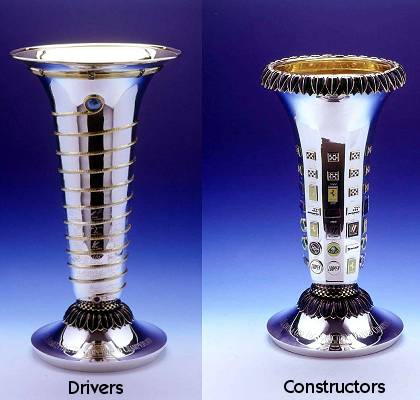 |
| The F1 logo...the 'F' and '1' also make a one in the spacing between them! |
Formula 1 for those
who don’t follow it, is so-called ‘sport’ where they make weird looking cars go
round and round, some guys crash and some go in a separate lane and get theirs
tyres changed super-fast...and the one who is at the foremost of the pack wins
and does some showboating by spraying champagne on people around him. And well
if now you are thinking ‘holy cow, this guy reads my mind! Isn’t this all what
F1 is ?!’ then my naive friend you absolutely need to have a through look at
this article!
F1 is the final word when it comes to technology, team
spirit, physical fitness levels and big money along with lavish lifestyles!
This entire saga began in 1951 when the first official F1 championship was
held...well it wasn't a very big commercial avenue like today. It was more of
manufactures like Mercedes, Ferrari, Alfa Romeo, Maserati and even some private
players coming together pitting their machines against one and other with a
pack of very gutsy drivers to help them achieve glory. As the rules kept changing
the cars began evolving along with the sport and today we have around 800bhp
monsters which can reach speeds of up to 340 kmph, accelerate from standstill
to a 100 kmph in 1.7 secs and 200 in 3.8 secs and touch 300 in around 9
seconds! And can pull almost 5 G of force and just weigh around 650-700 kgs.
 |
| A 2011 Red Bull Racing F1 car and a 1956 Maserati F1 car |
All this is
possible only by continuous development, heavy investments and a passion to
strive for the best. These factors are solely responsible for the sport to be
at the pinnacle of technology and these innovations eventually trickle down to
passenger cars making them faster, more fun and safer to drive. Most of the
automotive technologies that we are used to have come from F1...from ABS to
active suspension the credit goes to Formula 1. Currently F1 uses a KERS
system; it stands for Kinetic Energy Recovery System...all this jargon means
that the kinetic energy of the moving vehicle which is wasted in the form of
heat while braking is converted into electric energy and is stored. This energy
can be used by the driver as boost of 60-90 bhp for duration of 6 seconds. A
couple of decades down the line, when your son will be insisting on a sexy
looking electric saloon, I am pretty sure that today’s KERS inspired tech will
be the backbone of that car!
Here's an amazing animated video, explaining the KERS system and also the DRS (Drag Reduction System) in detail..
And well, to be able
to handle and make all this technology work in perfect harmony the driver acts
as the pivot...and despite all this even today the most advanced F1 car is
nothing without a deserving driver. But we will have more on that later, a
small paragraph wouldn’t do justice to this different breed of humans...they
deserve an entire article! What makes a race interesting and much more than 24
cars going round and round, are multitude of factors ,some controllable and
some not. This year the new Pirelli tyres have shaken things up considerably
with their short life span...this has resulted in more pit-stops and thus race strategy
becomes more prominent. Many places have been lost and gained just because of botched
pit-spot strategy and has won drivers races where it seemed to be impossible to
overtake on the track. And this is just
the tip of the iceberg, weather conditions, car setups, mechanical and electrical
gremlins and many more factors are able to maintain the air of uncertainty until
the chequered flag is waved and the driver crosses the finishing line.
As of now almost half of the 2011 season is over, last year’s
constructors’ champion Red Bull Racing is still dominating and Sebastian Vettel
is still leading the current championship table. Today the race is held at
Nurburgring in Germany, it’s the 10th race of the season out of the
total 19 races. An interesting fact to note is that this time ‘round, 25% of
the drivers on the grid are German! So the pressure to perform in front of the
home crowd would be immense, but drivers say that it acts more as a motivation
to them. And another thing that is out of the ordinary is that, the turns 8 and
9 in the Nurburgring track had been christened as the ‘Schumacher S’ after Michael
Schumacher retired in 2006...he made a heroic comeback to F1 last year, and I
think it’s the first time a driver would race on corners named after him...what
pride! After yesterdays qualifying, Mark Webber has taken the pole and Lewis Hamilton is 2nd on the grid with Vettel 3rd and the Ferraris of Alonso and Massa not far behind. The earlier half of the season was largely dominated by Red Bull and the closest contenders Mc'Laren Mercedes and Ferrari were lagging behind a lot. But of-late they have caught up and have brought the fight to the defending champions.With all 3 top performing teams pretty closely tied, it sure makes for a very tantalizing race ahead with rain forecasts, victory could be anybody's bet!
So now what are you
waiting for! Sunday 5:30 pm do switch over to Star Sports or ESPN HD (if you
are the few lucky ones to receive that channel, unfortunately I am not) and
enjoy the broadcast of the German Grand Prix live. If speed, technology,
super-human driving skills, sportsmanship, ‘clockwork precision’ team work
gratify you like cocktail waitresses gratify Tiger Woods...join the band-wagon
and dive head first into the realm of Formula 1...
-Gaurav Singh
-Gaurav Singh















